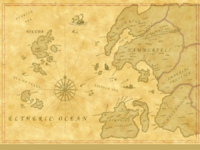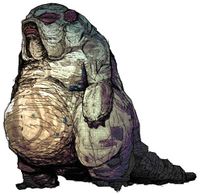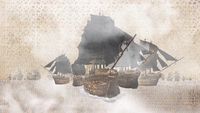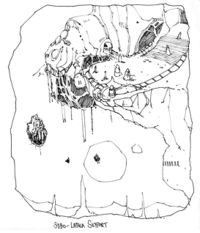Lore:Thras
| This page is currently being redesigned for the Lore Places Project (LPP). The page may need work to meet the standards outlined on the project page. |
| Thras | |
|---|---|
| Type | Archipelago |
| Region | Eltheric Ocean |
Thras, also known as the Coral Kingdoms,[1] the Sloadlands[2] and the Thrassian Archipelago, is an archipelago located southwest of the Chain in Tamriel,[1] within the Sea of Pearls.[3] It is the little-known home of the Sload,[4] and was the source of the deadly Thrassian Plague that swept Tamriel in 1E 2200. In response to the Plague, the people of Tamriel assembled the All Flags Navy, which sunk the islands of Thras, though the surviving Sload managed to bring the islands back to the surface.[1] The Pillar of Thras, a thousand-foot-tall spiral of coral said to be a portal to Oblivion, stands on the largest island. The Sload make sacrifices here, and while many of them die, a few seem to disappear a moment before being dashed on the rocks.[5]
The geography of Thras appears to change over time. The earliest maps of Thras show a semi-circular group of sixteen islands, similar in formation to a partially-submerged coral atoll. The number and size of the islands varies significantly in maps charted over subsequent centuries. Agonio, the largest island in the archipelago, is depicted as much larger in the most recent maps than it was in the oldest. It is unknown if this fluctuation is caused by the tides or other, possibly unnatural means.[6] Some sources suggest the archipelago itself may be some sort of living organism.[UOL 1][UOL 2] The most consistent feature of Thras is a brackish lagoon found in the archipelago's center, where the Sload are able to move with relative quickness and grace using a network of coral formations and ancient shipwrecks.[6]
Contents
History[edit]
Early History[edit]
Much like the beastfolk being the aboriginals of Tamriel since the early Merethic,[7] the Sload are the tribe of beastmen native to Thras.[1][4] The Sload of Thras may have been original inhabitants of Summerset as well,[6] as the oldest of all the ruins there are made of coral, thought to have been carried a great many miles away from the sea. The material and style of the ruins strongly suggest that the Sload may have once counted Summerset as a part of their kingdom of Thras.[8]
The Sload used necromantic magic and infernal machines to attack the Altmer since before recorded time, conjuring sea monsters along the coasts and capturing many Altmer, though they have never succeeded in reclaiming Summerset.[6] During the first of the Altmeri formwars, some Altmer took on aquatic forms to become dreughs and sieged the necromantic meatmerchants of Thras back into their misdesigned corals sandboxes.[9][UOL 3] An unnamed ship of Topal's fleet travelled north-west Summerset, towards Thras and Yokuda. It is thought that this ship and Pasquiniel may have perished at the hands of the ancient Sload, as they did not return.[10]
The first maps from cartographers who sailed to Thras and returned to tell the tale showed a group of sixteen islands, and over the centuries other maps with a different number of islands and layouts have been charted by spies, suggesting that the region's landmass fluctuates. Agonio has been shown to be getting bigger as the years go by.[6] The sload visited horrors upon Summerset during the Sack of Skywatch in 1E 1301, capturing some Altmer to bring them back to Thras.[8] The few Altmer that escape mention being kept in a lagoon at the center.[6]
Thrassian Plague and Fall of the Sload[edit]
The Sload unleashed the Thrassian Plague in 1E 2200, which decimated more than half of Tamriel's population, particularly the western coastlands closest to Thras.[11][12] In an event known as the Fall of the Sload,[13] Bendu Olo, the Baron-Admiral of the All Flags Navy, led the largest allied naval force in Tamrielic history to Thras, slaughtered all the Sload they could find, and sunk their coral kingdoms into the sea with great unknown magicks.[1] While it's unknown when the disease fully subsided, cases of the Thrassian Plague were still being reported near Wayrest over four hundred years after its initial outbreak.[14] The effects of the Plague and the Fall were very impactful; Olo was thereafter known as the "dealer of swift justice" to the Foul Spot of Thras,[1] and the glory of the Cyrodilic people became known throughout the world.[11] Elsweyr was reduced from 16 down to 2 kingdoms,[15] Valenwood later fell to the Empire from being weakened by the plague,[16] and Hammerfell was on friendlier terms with its neighbors, all as a result of the Fall.[17]
Post-Sinking and Rise[edit]
The Sload were long presumed extinct after the Fall.[1] They recovered by the end of the era, and waged the War of the Uvichil from 1E 2911 to 1E 2917, regarded as one of the most terrible events in Tamriel's history.[8]
By 2E 864, Thras was considered a "free" or "wild region" by the Septim Empire, and it was reported that it had risen again. Imperial authorities encouraged citizens to report the existence of its masters, the Sload, if seen in the various areas of Tamriel.[1]
In 3E 120, maps of lands beyond Tamriel, including Thras, could be seen in the Map Room of the Blue Palace.[18] By the waning years of the Third Era, from 3E 402 to 3E 432, the western seas were very quiet and Agonio had become considerably great in size, giving hope to Tamriel that the Sload had retreated back to Thras for good.[6]
Culture[edit]
All their heroic myths from Thras are about individuals who "sit around and think for years" on end, consulting cautiously with wise Sload, until finally they act with deliberation, always successfully. All their mythic villains act quickly, and always fail.[1] Though a godless people, the Sload Priests commune with the God of Worms following the Warp in the West.[UOL 4]
The Sload sacrifice victims atop the Pillar of Thras, where some are killed by the fall, while some vanish before being dashed on the rocks. The sload do not seem certain why some were taken and some died, or even care regardless.[5] When mummifying corpses in Thras, a higher amount of salt is needed for them to be saturated due to the region's moisture.[4] It is uncertain whether Sload only practice Necromancy on other races in Thras, like they do in Tamriel, or if they practice it on each other in their homeland.[4]
Transportation[edit]
Younger adults lack essential surface survival skills, and are rarely seen on land. All land-traveling Sload know the Recall spell, and use it casually and frequently as the default mode of travel around Thras.[1] Sload floaters are a type of airship used for mass transit and warfare, which are living gasbags.[UOL 5][UOL 6] They are rumored to use these to carry slaves from Tear and corpses from Senchal.[4][UOL 7] Abecean sailors rarely had sload-clusters barnacled to their ships, and beat sloadbags so that the "Thras gas" could steer them farther.[UOL 8] The buoyant native creatures may move about with relative quickness and grace in the brackish lagoon at the center of the island chain, through an intricate network of coral formations and ancient shipwrecks.[6]
Geography[edit]
Thras is described as a set of islands[1][16] of a fluctuating number,[6] first reported as a group of sixteen islands in a semicircle similar to a partially submerged coral atoll. It is thought that the volatile nature of the changing landmass is brought upon by strong tides or other less natural means.[6] Agonio, the largest of the islands, appears the most stable. A black lagoon is found in the center of Thras, thought to be its true and permanent aspect, where intricate coral reefs and large shipwrecks are found.[6] It is much too small to be considered a continent on its own, and is not part of Tamriel in any kind of political or cultural way.[UOL 9] Only a rough location of it is known, being in the Sea of Pearls, southwest of The Chain and nearby Summerset.[1]
Thras has a very moist climate.[4] The Sload live in both the waters and islands of Thras, growing in the water during their youth before moving onto the land when they mature.[1][19]
Notable Places[edit]
- Agonio
- The ever-growing largest and most stable island of the archipelago
- Coral Tower
- Pillar of Thras
- A thousand-foot tall spiral of coral, where sacrifices made to plunge off it either land on the rocks below or vanish mid-air.[5]
- Ul'vor Kus
Flora and Fauna[edit]
The Sload are native to Thras.[4] They are known to conjure "sea monsters" to attack Summerset.[6] They are also known to slaughter and revive various sea creatures such as turtles and crabs to keep as pets.[20] Abnormally large nautiluses were located in the waters surrounding Agonio. Since it was the largest island in the archipelago, the antiquarian Gabrielle Benele theorized the abundant resources of Agonio allowed them to grow to larger sizes.[21]
Gallery[edit]
Notes[edit]
- "Dagoth Thras" was a powerful daedra-worshipper who declared himself the heir of the Sixth House, but it is never stated that his name shares relation to the region.[22]
- The Thrassian Plague itself predates Thras conceptually, as the first mention of Thras was in the Pocket Guide whereas the Thrassian Plague originated in Daggerfall.
References[edit]
- ^ a b c d e f g h i j k l m Pocket Guide to the Empire, 1st Edition: The Wild Regions — Imperial Geographical Society, 2E 864
- ^ Systres History — Trilam Heladren, Associate Dean of Eltheric History, University of Gwylim
- ^ Journal of Tsona-Ei — Tsona-Ei
- ^ a b c d e f g Corpse Preparation
- ^ a b c The Doors of Oblivion — Seif-ij Hidja
- ^ a b c d e f g h i j k l Pocket Guide to the Empire, 3rd Edition: Other Lands — Imperial Geographical Society, 3E 432
- ^ Before the Ages of Man — Aicantar of Shimerene
- ^ a b c Pocket Guide to the Empire, 3rd Edition: The Blessed Isle: Alinor and the Summersets — Imperial Geographical Society, 3E 432
- ^ The 36 Lessons of Vivec — Vivec
- ^ Father of the Niben — Florin Jaliil
- ^ a b Pocket Guide to the Empire, 1st Edition: Cyrodiil — Imperial Geographical Society, 2E 864
- ^ Pocket Guide to the Empire, 3rd Edition: All the Eras of Man, A Comprehensive History of our History — Imperial Geographical Society, 3E 432
- ^ Varieties of Faith... — Brother Mikhael Karkuxor of the Imperial College
- ^ Wayrest, Jewel of the Bay — Sathyr Longleat
- ^ Pocket Guide to the Empire, 3rd Edition: Sugar and Blood: the Cats of the South — Imperial Geographical Society, 3E 432
- ^ a b Pocket Guide to the Empire, 3rd Edition: The Wilds Remain: Valenwood — Imperial Geographical Society, 3E 432
- ^ Pocket Guide to the Empire, 3rd Edition: The Ra Gada: Hammerfell — Imperial Geographical Society, 3E 432
- ^ The Wolf Queen, v5 — Waughin Jarth
- ^ Notes on Racial Phylogeny — the Council of Healers, Imperial University
- ^ A Loathsome Civilization — Telenger the Artificer
- ^ Nautilus Shell Guards item description in ESO
- ^ Death Blow of Abernanit — Anonymous (with notes by Geocrates Varnus)
Note: The following references are considered to be unofficial sources. They are included to round off this article and may not be authoritative or conclusive.
- ^ Nemon's Memorystone — Nemon
- ^ Michael Kirkbride's Posts
- ^ How Beautiful You Are That You Do Not Join Us
- ^ Xanathar's Library Archive/History
- ^ Sload Floater and Skyport concept art
- ^ Nemon's Memorystone — Nemon
- ^ Letters from Oran Dres — Oran Dres
- ^ Tiber Septim's Sword-Meeting with Cyrus the Restless
- ^ Ted Peterson Interview
|
||||||||||||||||||||



